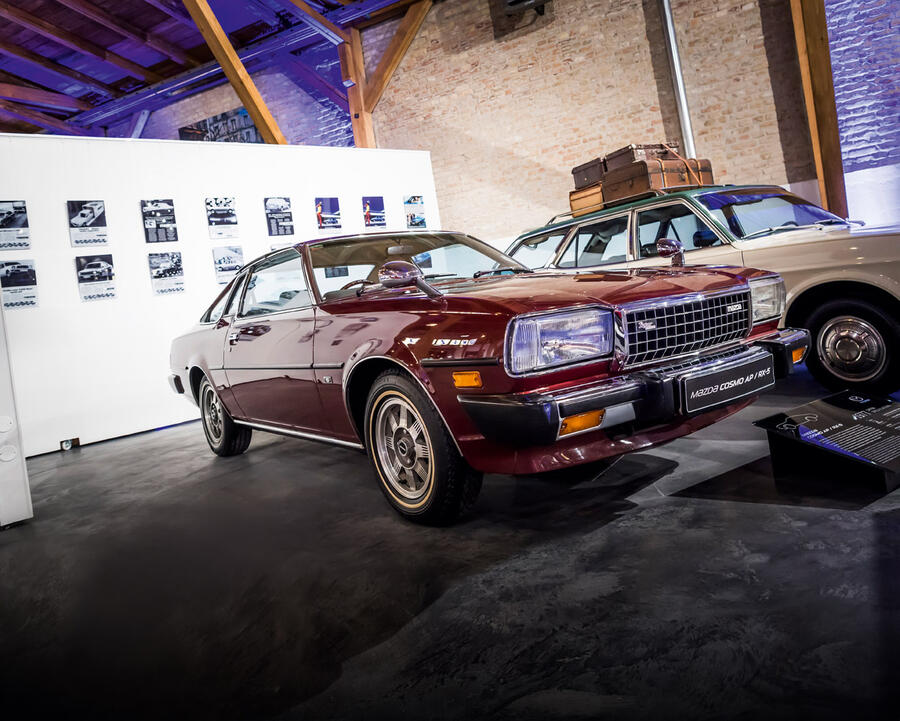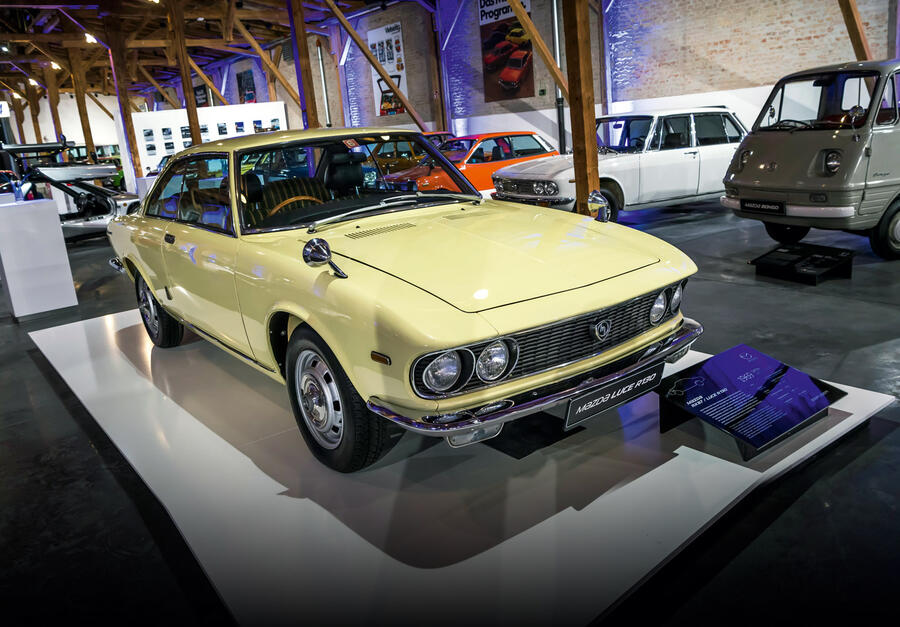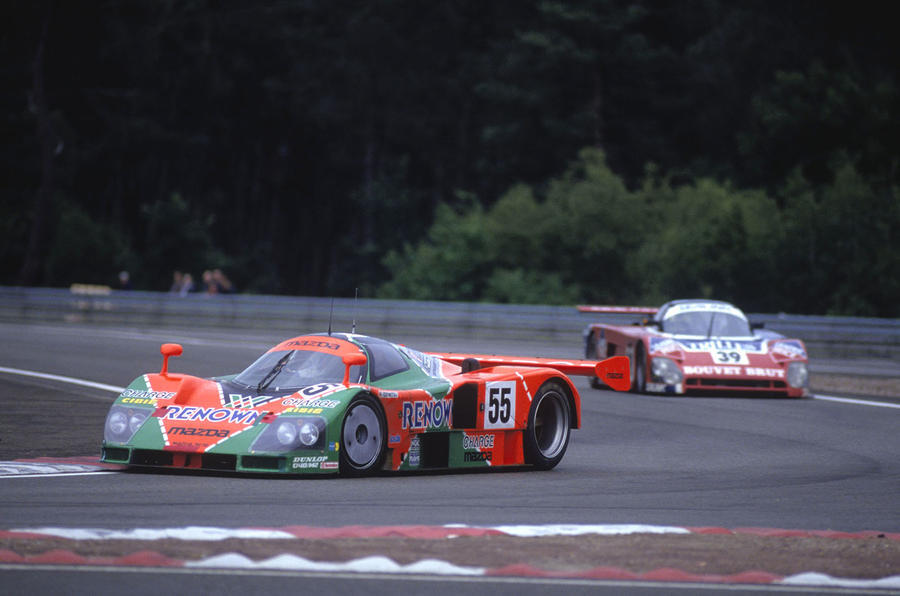If you’re going to celebrate 100 years of Mazda, surely a trip to Japan is just the ticket? Erm, actually, it turns out that it’s not. Hiroshima has been home to the company for a century, but to truly immerse yourself in its history, you actually have to head to the city of Augsburg in Germany.
This is where you will find the Frey Museum, home to the largest and finest collections of Mazdas anywhere in the world. With more than 50 cars on display and perhaps another 100 in storage, all of which run and are used, this unrivalled treasure trove of everything Mazda is the perfect place to delve deep into the brand’s car-making heritage.
Yet it all started with cork rather than cars. In 1920, the Toyo Cork Kogyo Company Limited was formed by Jujiro Matsuda in Hiroshima, producing synthetic cork to be used as a sealant in numerous industries. After a year or so, Matsuda moved into making machine tools and soon dropped Cork from his firm’s name.
In 1930 came its first vehicle and the first use of the Mazda name. The Mazda Go was a three-wheel commercial truck – essentially a mash-up of a motorcycle and pick-up. There’s a later (1950) example in the Frey Museum, and it’s one of two exhibits – along with the RX-7 Group B rally car replica – that rarely run, because its deafening exhaust rouses the neighbours into angry calls to the council at the first blip of the throttle.

Such was the domestic success of the Go that Mazda began work on its first car, a small two-door saloon that first ran in 1940. Japan’s entry into World War II, however, meant that this never made it past the prototype stage before the factory was turned over to making munitions. It would be another two decades before Mazda launched its next car.
Hiroshima was, of course, the target of the first of the two atomic bombs that the US dropped on Japan in August 1945, effectively bringing the war to an end. Mazda’s factory was extensively damaged, and what workshops remained were turned into makeshift field hospitals. Yet production of the Go restarted by the end of the year, and in 1949 Mazda started exporting for the first time.
Over the next 15 years, the firm grew as a manufacturer of commercial vehicles, and towards the end of the 1950s it had around 30 different types of pick-ups and vans on its books. Then in 1960 came the R360, the kei car that was its first passenger vehicle. The little 2+2 coupé was an instant hit, and before long Mazda was the biggest player in Japan’s tiny car class.
A year after the R360’s debut, Mazda acquired a licence from German manufacturer NSU to build a Wankel rotary engine. It spent years developing the unit before eventually putting it into production in 1967 in its glorious Cosmo 110S coupé.
This was also the car that fired up Walter Frey’s Mazda passion, and the example that takes centre stage in his museum is the first car he bought for the collection. Acquired from a New Jersey dealer in 1980, it was shipped to Germany for a full restoration.

Mazda’s range of mainstream motors gathered pace during the 1960s, with the Familia 800 and the larger, Bertone-styled Luce saloon, estate and coupé. It was towards the end of this decade that bosses began an export push, starting with Europe and then North America in 1970.
It was the US that took the brand to its heart, with the rotary proving particularly popular. In 1973, Mazda produced a quarter of a million cars powered by this engine and entered the top 10 of global manufacturers.
Yet this was also the year of the oil crisis, which hit thirsty rotaries hard, and two years later the US made catalytic convertors mandatory. In order to fit the cleaner exhausts, Mazda needed to borrow heavily; it ended up in so much debt that in 1974 it agreed to Ford taking what would ultimately be a 33% stake, originally with a view to Detroit getting the inside line on rotary technology, which Mazda had now perfected. NSU had given up in 1977, crippled by warranty claims for its Ro80.
The partnership enabled both to flourish, with Mazda accessing Ford’s considerable budget and Ford tapping into Mazda’s engineering expertise. Numerous models were co-developed, including the 323 and more recently the 2 and Mazda 3. Mazda bought back Ford’s shares and went independent again in 2015, before shortly after entering a partnership with Toyota with a focus on hybrid powertrain development.
One project on which Mazda went its own way was the Mazda MX-5. Dreamed up by American journalist Bob Hall and Mazda’s then president Kenichi Yamamoto, this lightweight two-seat roadster became an icon from almost the moment it was launched in 1989. As you would expect, Frey’s museum has loads of MX-5s on display, including a rare Mk2-based coupé of which only 179 were made.

Mazda has continued to innovate over the years, culminating with the novel Skyactiv-X compression-ignition petrol engine, and now there’s talk of the rotary returning as a generator for a plug-in hybrid.
One thing is for certain, though: whatever future models Mazda makes, there will always be room for them at the Frey Museum.
How it all started
Walter Frey’s passion for collecting started four decades ago with the Cosmo he bought in 1980, three years after opening his first Mazda dealership in Augsburg. Over the years, he has gradually built up his collection with purchases from all over the world, but it was only in 2017 that Frey was able to display them properly. He and his sons, Joachim and Markus, acquired a disused tram depot that dated back to 1897, completely refurbished it and made it the focal point for all things Mazda. It now holds around 50 cars, with the displays being regularly changed from the wider collection of somewhere close to 150 – a number that will continue to grow, because their reputation means they field offers for cars from all corners of the globe. Yet the one permanent item is the Cosmo that started Walter’s passion all those years ago.
Success was instant for Mazda’s first passenger car, the R360 of 1960, which quickly took 65% of the kei car market and 15% of all Japan’s new car sales. Powered by a 356cc four-stroke engine, it featured four-wheel independent suspension and remained in production for six years.
Styled by Giorgetto Giugiaro while he was at Bertone, this gorgeous pillarless coupé was the only rotary Mazda to be front-wheel drive. Only available on the Japanese market, it featured a 126bhp twin-rotor engine and a four-speed manual gearbox. Only 976 examples were produced over a three-year period.
1974 Mazda Repu
A high-revving rotary engine isn’t an obvious choice for a hard-working pick-up truck, but that didn’t stop Mazda building one. Known as the Repu (rotary-engined pick-up), it was sold only in the US and Canada and featured a four-carburettor twin-rotor that revved to 7000rpm. Around 15,000 were built between 1974 and 1977, and they’re now highly prized by American collectors.

Walter Frey’s favourite, the Roadpacer is actually a Holden. Wanting to take on the Toyota Crown in Japan, Mazda shipped the big saloon from Australia and fitted it with a 1.3-litre rotary engine. Sadly, it was slow and overpriced, so only 800 examples were sold before production ended after two years in 1977.
1976 Mazda Parkway Rotary 26
Perhaps the oddest rotary application is the Parkway. Fitted with a development of the RX-7’s twin-rotor engine, this 26-seat bus had 135bhp and a 75mph top speed – heady stuff for the mid-1970s, although we’re sure the fuel economy was terrifying.
This is a rare European-specification example of the rotary-powered RX-5 coupé, which Markus Frey bought from its original UK owner (it still has its last tax disc in the windscreen). After purchasing it online, Frey used it for a two-week holiday to Cornwall before driving it back home to Germany. It never missed a beat and remains his favourite from the collection.
Launched as Walter Frey opened his dealership, the 323 is the car that finally gave Mazda a foothold in Europe. With its rear-drive layout, it was out of step with rivals, but it was spacious, easy to drive and reliable. This green example was one of the original Frankfurt show cars that was driven from Hiroshima to Germany. It has been signed by many visitors to the museum, including Mazda’s current president.
There’s a corner dedicated to the RX-7, with one of each of the three iterations. Perhaps the most intriguing is this early turbocharged model, which was given to Felix Wankel – who couldn’t drive. Instead, he had a chauffeur, who he often encouraged into impromptu races with any Porsches they met at traffic lights.
Mazda's motoring innovations
SkyActiv-X engine: Mazda’s new spark-controlled compression-ignition 2.0-litre petrol engine matches the best qualities of diesel and petrol units. Even more remarkable is that it was tiny Mazda and not one of the bigger companies that made this breakthrough.
Four-wheel steering: Honda was the first to bring this to production in 1987, but when Mazda’s 626 4WS came along in 1988, it was far more sophisticated. With electronics controlling a hydraulic rack, the driver and rear wheels had no physical link between them.
Atkinson engine: Toyota claimed to have made the first Atkinson-cycle engine for 1997’s Prius, yet arguably Mazda beat it with the Xedos 9 of 1993. Use of a supercharger meant its V6 was technically a Miller-cycle engine, but the basic principles are the same.
Supercharged diesel: Supercharged diesel engines were used in lorries first, but Mazda began their use in cars with its 626 C-DX in 1988. Its pressurised wave system promised less power loss than a regular blower, although the 2.0-litre unit made just 75bhp.
i-Stop: Most brands bought in engine stop-start tech from suppliers; Mazda made its own. Sensors that detect which piston was on a power stroke when the engine stopped enable it to restart more smoothly and efficiently than others.
Recycled bumpers: Mazda became the first to use recycled materials on a car in 1992. Initially it used reformed materials for out-of-sight parts like undertrays, but by 2011 its process was so advanced that recycled plastic bumpers could be made into more bumpers.
SkyActiv engines: With the first Mazda CX-5 came the Skyactiv-G and Skyactiv-D engines. A 14:1 compression ratio (the highest yet for a petrol and lowest for a diesel) made them more efficient in use and in production, as they could be built on the same line.
Hydrogen wankel: It’s no surprise that Mazda was first with a hydrogen-fuelled rotary engine. It effectively had separate combustion and intake chambers so needed no changes to run on the volatile fuel. It hit the road in 2007, but a lack of filling stations killed it.
Foreign boss: Mazda’s appointment of Henry Wallace in 1996 made it the first Japanese marque to be led by a foreigner. The ex-Ford man was a hit, boosting profitability without job losses. He was also famed for TV ads delivered in Scottish-accented Japanese…
Sat-nav: Many claim to have been first with sat-nav but, in terms of the systems used today, it was Mazda. An option on the 1990 Eunos Cosmo in Japan, it had a colour screen and, thanks to its satellite link, real-time positioning for the first time.
Motorsport
Le Mans 24 Hours 1991: Mazda’s crowning motorsport achievement came in 1991 as it became the first Japanese firm to win Le Mans. Its triple-rotor 787B (driven by Johnny Herbert, Bertrand Gachot and Volker Weidler) saw off Jaguar, Mercedes-Benz and Peugeot.

Spa 24 Hours 1981: Le Mans was the big one, but Mazda’s first taste of round-the-clock success came a decade earlier at Spa. It beat faster, more established rivals as local ace Pierre Dieudonné brought the TWR-run RX-7 home for victory by two laps.
Marathon de la Route 1968: For its first international race, Mazda ran two Cosmos in this 84-hour Nürburgring slog. One crashed but the other finished behind two Porsche 911s and a Lancia Fulvia – not bad for the virtually untried rotary coupé.
BSCC 1980-1981: Tin-top legend Win Percy used a TWR-prepared RX-7 to take back-to-back wins in the BSCC, the forerunner to the BTCC, in 1980 and 1981. He secured an impressive 19 class victories from 22 races over the course of the two-year campaign.
IMSA GTO Series 1991: Mazda has been a stalwart in US sports car racing since the 1970s, and its biggest success yet is the 1991 IMSA GTO title. Using a four-rotor, spaceframe RX-7, it took five class wins thanks to factory aces Pete Halsmer and Price Cobb.
Andros Trophy 2015: France’s ice-racing series has become a hit since it began in 1990, attracting stars such as Alain Prost and Yvan Muller. In 2014-15, Jean-Philippe Dayraut won the title in a Mazda 3 that had a 3.0-litre V6, four-wheel drive and four-wheel steering.
Indy Pro 2000 1983-now: Mazda’s one-make series has run since 1983 and served as a springboard for many Indycar stars, among them Graham Rahal, Marco Andretti, James Hinchcliffe and Scott Speed. The engines were rotary until 2018, when a four-pot came in.
Bathurst 1000 1975: Rotary Mazdas have done their fair share of giant-killing on track, the 1975 Bathurst 1000 being a highlight. Don Holland and Hiroshi Fushida fought from 19th up to fifth in their RX-3, with the only cars ahead top-class V8 Holdens.
IMSA Series 2017-new: Mazda remains a front-runner in sports cars with its RT24-P. Built for the IMSA series’ top class, it had its best season in 2019, with three wins. Mazda is in contention for the title this year but will scale back its effort to one car in 2021.
WRC 1985-1991: Mazda was a rally regular from 1985 to 1991. It started with a Group B RX-7, but the Group A 323 4WD was more successful; Timo Salonen won in Sweden in 1987, a feat repeated in 1989 by Ingvar Carlsson, who also won that year in New Zealand.
Mazda memories
Steve Cropley
The first time I ever drove a rotary-engined Mazda – a blue RX-3 coupé – was in early 1973, when I was completely new to road testing. It seemed impossibly smooth and powerful and had a 5500rpm powerband – 2500rpm to 8000rpm – that was completely outside my experience. You have to remember what was around then; Alfa Romeos redlined at 5700rpm and your MGB had a yellow sector at 5500rpm. The mainly pushrod fours we drove were thrashy and horrible. This Wankel was from another planet and would have been the answer to everything but for its unreliability (rotor seals) and fuel consumption (sub-20mpg). Mazda refined it for 40 years but in the end just couldn’t make it clean enough. It was exciting for every year of that journey, though.
Matt Saunders
I’ve had some great drives in Mazda MX-5s, but I’m far from alone in loving those, so I’ll instead recall a drive that I had 13 years ago in a hydrogen-powered RX-8, around the jaw-droppingly beautiful fjords north of Stavanger in Norway. The driving experience itself wasn’t too momentous (power output dropped by about 40% when the rotary engine was burning hydrogen). But there was something about the combination of the car, the incredible natural setting and the sense that I was sampling the fuel of the future that made it very memorable indeed.

James Ruppert
When my mate Steve needed a cheap set of wheels, I volunteered to sort something out for him. He had a ‘dad van’ for family duties, but there was a daily commute that required a second car on virtually zero budget. I squeezed £150 out of him and turned that into a local, unwanted-part-exchange Mazda 323 – a proper one from 1995 with pop-up headlights and a 1.8-litre petrol engine. Two years later, it was closing in on 250,000 fault-free miles and had proved to be the best car I had never owned.
READ MORE
Mazda reveals straight-six engine that could be used for next 6






















Add your comment